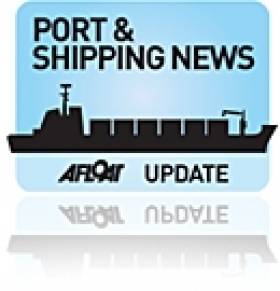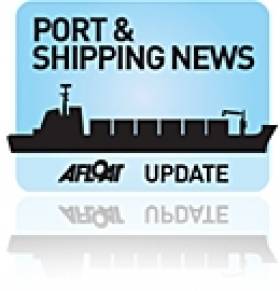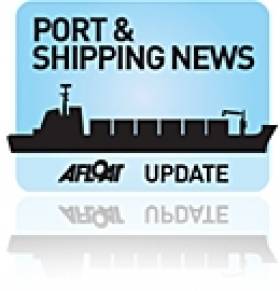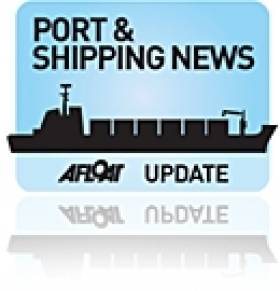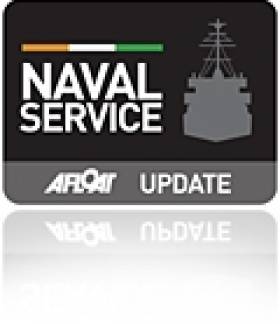Displaying items by tag: Ports & Shipping news
Airbus Wing-Carrier Vessel Refloated off Welsh Sandbank
#WINGSHIPRefloated – A ship designed specifically to transport huge Airbus A380 wings, Ciudad de Cadiz (2008/15,643grt) was successfully refloated this morning, following grounding on a north Welsh sandbank off Mostyn, more than a week ago, writes Jehan Ashmore.
The 125m vessel which operates between the port of Mostyn in Flintshire to Nantes, France, grounded on the Salisbury Sandbank on the Dee Estuary during 30 January.
She broke her moorings due to the severe weather conditions that led to the vessel beaching on the sandbank and within 1 nautical mile off the port's pier, to where she is now safely moored alongside.
| ShipSpotting.com |
 |
| © Barry Graham |
Previous attempts to free the vessel which has no cargo on board, failed due to the continued gales and insufficient tidal heights.
The vessel was ballasted down and in an upright and safe position with tugs in attendance while the Maritime Coastguard Agency (MCA) monitored the situaton. There were no reports of damage or pollution and that her 23 crew were reported safe and well remained onboard.
According to BCC North East Wales, the vessel is to head to Holyhead to undergo a full dive survey.
Ciudad de Cadiz, is one of three such specialist vessels that transport the wings manufactured at an Airbus plant at Broughton, from there they are firstly taken by road, then driven onto a custom-built stern-loading barge before finally reaching the port.
The components are then transferred via the pier's ro-ro linkspan and through the ships stern door ramp, and then sailed across the Bay of Biscay to Nantes (Montoir-de-Bretagne). From there the final leg of the journey is by road to the company's assembly factory at Toulouse in south-west France.
One of these ships, Ville de Bordeaux, (2004/21,528grt) had also recently called to Mostyn. The vessel which is jointly operated by two companies, had several years ago called to Rosslare to deliver trade cars, as the French partner's offshoot LD Lines, had run a short lived Rosslare-Le Havre ferry service by the ro-pax Norman Voyager.
Belfast Harbour’s Tonnage Record in 2012
#BelfastHarbour – Figures released by Belfast Harbour reveal that trade handled by the port during 2012 rose to a record 19.6m tonnes, up 11% on the previous year. The growth was driven primarily by an improved performance in the bulk and roll-on / roll-off (freight vehicle) sectors.
A record 4.6 million tonnes of dry-bulk was handled, a jump of 16%. This included 2m tonnes of grain and animal feeds, the highest tonnages ever recorded by the harbour in this sector.
An additional 600,000 tonnes of coal was also handled, reflecting recent investments by the harbour in deep-water facilities which have enabled it to handle coal imports for AES's power station at Kilroot, on the northern coast of Belfast Lough. Coal imports are now in excess of 1m tonnes for the first time since 1996.
Major investments by Belfast Harbour and Stena Line in new terminals on both sides of the Irish Sea, plus a pair of new superfast ferries, have significantly enhanced the competitiveness of the Belfast – Cairnryan route.
Port Tonnages Rise by 11%
This, coupled with a record performance on the Belfast – Heysham route, helped drive the number of freight vehicles passing through the Port to 432,000, up 21% since 2011.
Commenting on the figures, Roy Adair, Belfast Harbour's CEO, commented: "It's greatly encouraging for Belfast Harbour to once again be able to report such a positive set of trade figures. Growth across a number of sectors reaffirms Belfast's position as one of the most efficient ports in these islands and helps benchmark the harbour's ongoing contribution to the Northern Ireland economy.
"Long-term investments by the harbour and by key port users such as Stena Line have delivered significant benefits to the regional economy. It is particularly pleasing that the roll-on / roll-off traffic has performed so strongly in what is one of the most competitive sectors in the port industry. "
Liquid Bulk total imports in 2012 remained steady compared with the previous year, with 2.1 million tonnes handled. Container traffic fell back by 5% to 123,000 boxes as consumer demand continued to soften. Construction related trades such as timber also continued to decline. Timber imports fell for the seventh year in a row, down by 9%.
On a more positive note, there was some indication of a recovery in activity in Northern Ireland's manufacturing base with steel imports rising by 11% to 128,000 tonnes, the highest level since 2008.
Passenger numbers using the port's ferry services also increased by 11% to almost 1.4 million, reflecting the growing popularity of 'holidays at home' and major boosts to Northern Ireland's tourist sector with the opening of Titanic Belfast and the new Giant's Causeway visitor centre. The 'Titanic' effect was even more evident in the cruise sector with 45 ships and 75,000 visitors calling at Belfast in 2012 – a rise of 40% since 2011.
Joe O'Neill, Belfast Harbour's Commercial Director added: "While the overall trend in tonnages handled is positive, the harbour is ever mindful that the wider economic outlook remains challenging. The record level of trade handled in 2012 was a direct consequence of a major investment programme; similar investments will be required for the long-term competitiveness of the port.
"For example, the trend for ever larger vessels plus Belfast's growing popularity as a cruiseship destination – bookings for 2013 are already up by over 25% - will require further investments in the port's deep water facilities to accommodate demand.
"Belfast Harbour will also continue to pursue major marine projects such as the development of a £50m, 50-acre offshore wind farm terminal for DONG Energy."
Ports Urge European Leaders Not to Cut Transport Infrastructure Budget
#EUROPORTS – European Heads of State and Government are coming together this week, in another attempt to make a deal on the Multi-Annual Financial Framework (MFF), the overall European budget for the years 2014-2020 and the budgets to be allocated to the different policies.
European sea and inland ports are urging European leaders not to touch the envelope of €31.7 billion foreseen for Europe's transport infrastructure investments under the Connecting Europe Facility (CEF).
Last spring, the European Federation of Inland Ports (EFIP) and European Sea Ports Organisation (ESPO) took the lead in a campaign set up by 28 European transport organisations to secure the TEN-T budget. Both organisations also encouraged their members to sign the declaration that was initiated by Commission Vice-President Siim Kallas at the end of last year.
EFIP Director Isabelle Ryckbost points out: "The proposed TEN-T budget is aimed at financing a concrete transport infrastructure plan, that will benefit all transport modes, Member States and regions.
The €31.7 billion will not only serve transport as such. By optimising transport links and transport nodes, all other policies, not in the least Europe's cohesion and agriculture policy will benefit. In that sense, the TEN-T budget has a real spill over effect and can be considered as one of the best ways of spending European money. It would be a shame if European leaders were to cut this budget and plan."
ESPO Secretary General Patrick Verhoeven confirms: "We hope European leaders will realise that a 3% share of the overall budget is a bare minimum for a sector that directly employs 10 million people and counts for about 5% of GDP.
This is certainly the case for ports. Ports are real job creators and engines for regional development. Moreover, as the main gateways to the world, seaports are essential to ensuring Europe's economic growth."
Increase in Trade Traffic 2012 Levels for Port of Cork
#PortofCork- A total 9.05 million tonnes was recorded in trade traffic at the end of 2012, according to the Port of Cork Company. This is an increase of 2% compared to 2011 figures and it is the first time traffic figures in the port have surpassed 9 million tonnes since 2008.
2012 was a very challenging year across many sectors including the Irish port sector with the import of goods through Irish ports reported to have fallen by up to 11%. However, the Port of Cork container volumes has shown an increase of 6% with over 165,000 TEU handled during 2012 and imports, excluding oil, are up by 12%. Imports of animal feed stuffs increased by 58% compared to 2011 while fertiliser, cereals and other trades have shown a marginal decrease in 2012.
Oil traffic remained steady despite the lower levels of domestic economic activity; however exports of refined product from Phillips 66 Whitegate Oil Refinery were strong and continue to be a significant part of the Port of Cork business. Exports are a key driver in the successful recovery of the Irish Economy and the Port of Cork is committed to continuous support in the growth of international trade for the country's economic prospects and job creation.
Remarking on the end of year trade traffic results, Mr Brendan Keating, Chief Executive of the Port of Cork said: "The Port of Cork is pleased to announce that our total trade traffic in 2012 remained strong and overall we are starting to see some stabilisation in trade levels in and out of the Port. With 98% of volume of all goods imported or exported from Ireland moved by ship, the importance of ports to our economy is of vital strategic importance. We will continue to look to the sectors that are performing strongly, such as food exports and will seek to capitalise on the demand for such goods from Europe and emerging markets."
He continued: "The Port of Cork is a key link to the continued economic success of Ireland and in particular the entire Munster region. The challenge now facing us in 2013 is to continue to develop the Port in order to meet the needs of the Country as it emerges from this current recession. We will continue to be extremely active in the emerging trends and logistic supply changes to reinforce our existing strength as the primary deepwater port in the south of Ireland and build on our progress to date".
Port officials are pro-actively engaged with tourism interests, County and City Councils and destination attractions to enhance the product on offer to the visiting cruise lines with a view to growing the business further through its dedicated cruise terminal. 57 cruise vessels visited the Port of Cork during 2012 bringing almost 100,000 passengers and crew to the region and the Port is scheduled to accommodate 64 vessels in 2013.
The Port of Cork was awarded two Cruise Insight Awards for 'Best Shore Side Welcome' and 'Best Tour Guides' which were announced at the global shipping conference, Seatrade Miami in April 2012. This achievement highlighted the outstanding team effort and commitment by the Port of Cork to deliver an excellent service to the visiting cruise lines and their passengers when in Cork.
The Port is delighted to be supporting The Gathering for 2013 and is actively ensuring that all visitors who transit through our facilities receive a warm welcome to Irish shores. Brittany Ferries remained steady on its weekly ferry service from Cork to Roscoff and the Port remains fully committed to establishing new routes and services from Cork.
The Port of Cork's recreational strategy continues to expand with the aim of improving the marine leisure facilities around Cork Harbour.
French Naval Defence Giant to invest €130m in OpenHydro
#OpenHydro- A French naval defence and energy-company, DCNS, has agreed a €130 million investment in OpenHydro, an Irish hydro-power firm.
The Paris-based giant, which among its activiities includes building submarines, yesterday outlined its expansion plans for OpenHydro, a tech company developing marine power alternatives.
As part of the deal DCNS will extend its stake in OpenHydro from 11 per cent to a controlling 59.7 per cent, subject to regulatory approval. To read more on this story, The Irish Times has a report.
Live Cattle Exporters Visit Ireland to Reopen Libyan Market
#CATTLESHIP- The Irish Times reports that live cattle exporters recently visited Ireland to examine reopening the Libyan market over the next few weeks.
Libya was a valuable market for Irish live cattle exports in the past, taking 81,420 cattle valued at more than €70 million in 1995. However, the business came to an abrupt stop in 1996 when Libya banned beef imports because of the BSE outbreak.
IFA president John Bryan said he had met with a major live exporter to north Africa in recent days, and it appeared that a ship would be ready in the coming weeks.
He said a strong live export trade was "absolutely essential" for the €2 billion Irish beef and livestock sector. Mr Bryan called for an immediate resumption of the live trade for livestock to Egypt and Lebanon. Bryan also called for an immediate resumption of live cattle trade to Egypt and the Lebanon.
However, he encouraged farmers to only accept secure payment. "Farmers should sell their cattle through their local livestock mart where payment is secure, and insist on payment upfront if selling off the land."
Ports & Shipping Review: Manx Route Opens, Toxic Cargo-ship Leak, Replenishment at Sea, Cruise Callers, Ferry Festive Boost, Arklow Newbuild and much more
#PORTS & SHIPPING REVIEW - Over the last fortnight Jehan Ashmore has reported from the shipping scene where the Manx-UK winter operated Douglas-Liverpool (Birkenhead) route resumed service.
The port of Warrenpoint on Carlingford Lough was where 18 people suffered injuries arising from a toxic gas leak onboard Arklow Meadow, a dry-cargsship which had arrived with a cargo of grain.
For the sixth year in succession the Irish Travel Trade News Travel Awards voted Irish Ferries as Best Ferry Operator of the Year 2012.
A new book New Life for churches in Ireland, has been published and in which features the former Mariners' Church of Ireland, Dun Laoghaire, now home of the National Maritime Museum of Ireland.
Coliemore Harbour on Dalkey Sound (the medieval port for Dublin) is to undergo a survey to access structural damage on behalf of Dun Laoghaire-Rathdown County Council.
The Naval Service was kept busy within the first fortnight of this month with the detention of two foreign registered vessels for alleged breaches of fishing regulations off Castletownbere.
In a first for the Commissioners of Irish Lights and the Naval Service, a joint replenishment at sea (RAS) exercise took place involving the ILV Granuaile and coastal patrol vessel CPV L.É.Ciara (P42).
Killybegs based Sinbad Marine Services have put on sale the SMS Coastal Cat, a 12m survey workboat built locally at the Mooney Boats yard.
In 2013, ten cruise calls are scheduled to visit Dun Laoghaire, bringing around 10,000 visitors and where the 148,528 tonnes giant liner Queen Mary 2 is to make an anchorage call in mid-May.
Dutch owned heavy-lift specialist Abis Shipping are seeking professionals and trainees to work for the expanding company which this month is due delivery of newbuild Abis Dublin.
In an unprecedented move Irish Ferries are to add a third vessel between Dublin-Holyhead during Christmas and New Year periods while Stena Line are to bring back HSS fast-craft operations between Dun Laoghaire-Holyhead.
In what will be a third order for a wind-farm support vessel from Gardline UK has gone to Arklow Marine Services, the 19m newbuild is to be completed in July 2013.
French Route Ferry to Dry-Dock Leaves Single Service Operator
#FERRY DRYDOCKING - Only two round trip Irish Ferries operated Rosslare-Cherbourg sailings are to remain before the year is out, writes Jehan Ashmore.
The cruiseferry Oscar Wilde is to undergo annual maintenance and routine inspection during January before opening the French service in late February 2013.
In the interim period this leaves Celtic Link Ferries which also runs to Cherbourg, as the only operator serving a direct year-round service using the ro-pax ferry Celtic Horizon.
The third operator on the Irish-French market, Brittany Ferries whose flagship Pont-Aven completed sailings for this year in early November.
Fishing Vessel Detained off South-East Coast
#NAVY– The Naval Service has detained a fishing vessel off the south-east coast over alleged breaches of fishing regulations, reports the Irish Examiner.
The L.E. Emer (P21) detained the Irish-registered boat around 19 nautical miles from Mine Head in Co Waterford yesterday evening.
The vessel was escorted to Cork and handed over to Gardaí in the early hours of this morning. More than 1,200 boardings and 17 vessels have been detained by the navy so far this year.
Belfast Harbour Launch Masterplan
#BELFAST PORT – Plans for the future of Belfast Harbour has been outlined for the next 20-30 years with the publication of a Masterplan.
Interested parties are invited to download the document from the port's website. Those parties wishing to offer commentary on the plans are asked to follow the response instructions at the end of the document and provide comments before 7 December 2012.
An improved performance in both turnover and profits were recorded during 2010-2011. According to the harbour's annual report a 2% rise was achieved in profit before taxation to £17.8m and a 4% increase in turnover totalled £36.1m


























